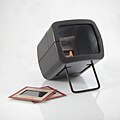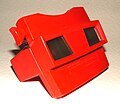
135 is photographic film in a film format used for still photography. It is a cartridge film with a film gauge of 35 mm (1.4 in), typically used for hand-held photography in 35 mm film cameras. Its engineering standard for the film is controlled by ISO 1007.
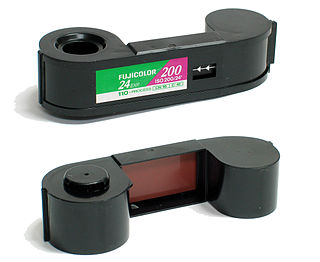
110 is a cartridge-based film format used in still photography. It was introduced by Kodak in 1972. 110 is essentially a miniaturised version of Kodak's earlier 126 film format. Each frame is 13 mm × 17 mm, with one registration hole. There are 24 frames per cartridge, although production variations sometimes allowed for an additional image.
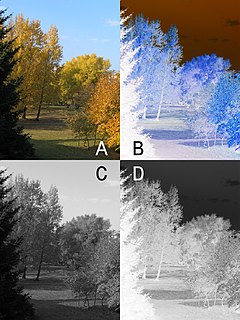
In photography, a negative is an image, usually on a strip or sheet of transparent plastic film, in which the lightest areas of the photographed subject appear darkest and the darkest areas appear lightest. This reversed order occurs because the extremely light-sensitive chemicals a camera film must use to capture an image quickly enough for ordinary picture-taking are darkened, rather than bleached, by exposure to light and subsequent photographic processing.
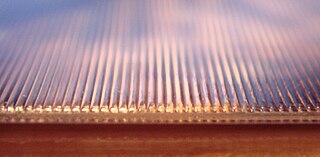
Lenticular printing is a technology in which lenticular lenses are used to produce printed images with an illusion of depth, or the ability to change or move as the image is viewed from different angles.
A stereo display is a display device capable of conveying depth perception to the viewer by means of stereopsis for binocular vision.

A stereo camera is a type of camera with two or more lenses with a separate image sensor or film frame for each lens. This allows the camera to simulate human binocular vision, and therefore gives it the ability to capture three-dimensional images, a process known as stereo photography. Stereo cameras may be used for making stereoviews and 3D pictures for movies, or for range imaging. The distance between the lenses in a typical stereo camera is about the distance between one's eyes and is about 6.35 cm, though a longer base line produces more extreme 3-dimensionality.

The Nimslo is a stereo camera with a brightfield viewfinder that produces 3D pictures that can be viewed without glasses. This is done using Lenticular printing. It uses common 35 mm film in 135 film format cartridges. It was produced in the 1980s by Nimstec Atlanta, Georgia, USA, and manufactured by Timex in Dundee, Scotland.
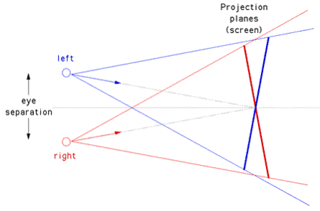
A 3D stereo view is the viewing of objects through any stereo pattern.

The Kodak Stereo Camera was a 35mm film stereo camera produced between 1954 and 1959. Similar to the Stereo Realist, the camera employed two lenses to take twin shots of scenes, which could then be viewed in dedicated image viewers. The lenses supported adjustable apertures and variable shutter speeds. The camera had a reputation for being easy to use, and sold approximately 100,000 units during the time it was produced.

The View-Master Personal Stereo Camera was a 35mm film camera designed to take 3D stereo photos for viewing in a View-Master. First released in 1952, the camera took 69 pairs of photos on a 36-exposure roll 35mm film, taking one set while the film was unwound from the canister, and another set while it was rewound. Although focus was fixed, the camera supported both variable aperture settings and shutter speeds.

The Fujifilm FinePix Real 3D W series is a line of consumer-grade digital cameras designed to capture stereoscopic images that recreate the perception of 3D depth, having both still and video formats while retaining standard 2D still image and video modes. The cameras feature a pair of lenses, and an autostereoscopic display which directs pixels of the two offset images to the user's left and right eyes simultaneously. Methods are included for extending or contracting the stereoscopic baseline, albeit with an asynchronous timer or manually depressing the shutter twice. The dual-lens architecture also enables novel modes such as simultaneous near and far zoom capture of a 2D image. The remainder of the camera is similar to other compact digital cameras.
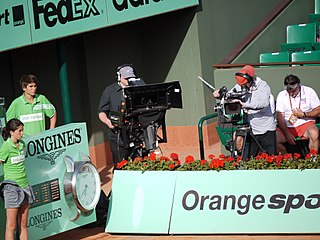
Stereo photography techniques are methods to produce stereoscopic images, videos and films. This is done with a variety of equipment including special built stereo cameras, single cameras with or without special attachments, and paired cameras. This involves traditional film cameras as well as, tape and modern digital cameras. A number of specialized techniques are employed to produce different kinds of stereo images.

Sawyer's, Inc. was an American manufacturer and retailer of slide projectors, scenic slides, View-Master reels and viewers, postcards, and related products, based in Portland, Oregon. Founded in 1914 as a photo-finishing company, Sawyer's began producing and selling View-Masters in 1939, and that soon became its primary product. It later diversified into other photographic products, mostly related to film transparencies, and established manufacturing plants in Europe, Japan and India. By the early 1960s, Sawyer's was the nation's second-largest manufacturer of slide projectors, and by 1965 slide projectors had surpassed View-Master reels and equipment as a percentage of the company's annual sales. In 1951, the company moved from Portland proper to the unincorporated Progress area in Portland's southwestern suburbs. In 1966, Sawyer's was acquired by New York-based General Aniline & Film (GAF), and its product lines and facilities were taken over by GAF. It was a subsidiary company of GAF until 1968, when it became simply a division of that company, renamed the GAF Consumer Photo Division. For several years thereafter, GAF used "Sawyer's" as a brand name for its slide projectors.











